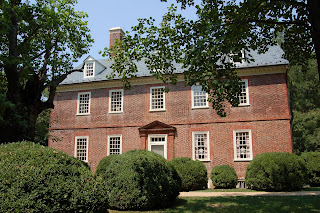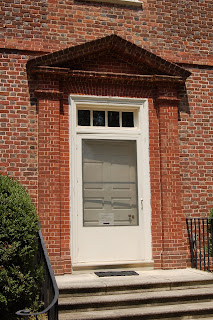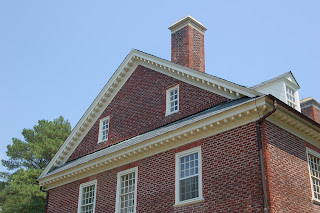
During the 17th and 18th centuries younger sons of English peers and less prominent gentry families found it increasingly difficult to establish themselves financially and socially. Primogeniture favored the oldest sons, who were able to inherit titles and estates, leaving second and third sons with little aside from land grants in the American Colonies. Many royalists also felt threatened during the English Civil War and Interregnum, leading some to emigrate to the colonies where they sought to create a new, landed aristocracy in the wilderness.
An early example of this aristocratic migration to the New World is Berkeley Plantation. Berkeley was founded in 1619 on the north bank of the James River about 20 miles upstream from Jamestown, the first permanent, English settlement in colonial America. The estate was acquired by Benjamin Harrison III in 1691 and this mansion built in 1726 by Benjamin Harrison IV. Later inhabitants of the estate included Benjamin Harrison V, a governor of Virginia and signer of the Declaration of Independence, and William Henry Harrison and Benjamin Harrison, both of whom would become president.
Constructed with bricks fired on the plantation, the building was designed in the Georgian Style. The Georgian Style reflects its classical heritage, where symmetry and order are the rule. The front of the house is perfectly balanced and centers on a pedimented, 8-panel front door (sadly obscured by an ugly, steel storm door). The bricks are patterned in the Flemish bond, where courses are composed of alternating headers and stretchers. Brick was favored in the Middle Colonies and the Flemish bond was characteristic of Georgian style.

 The cornice features heavy molding and dentils, which are more prominent than those found on the more refined Federal Style homes of the early 1800s. Try to ignore the ugly, aluminum storm window!
The cornice features heavy molding and dentils, which are more prominent than those found on the more refined Federal Style homes of the early 1800s. Try to ignore the ugly, aluminum storm window!
The gable end also shows the characteristic classical pediment with heavy, projecting molding and dentils. Also common on grand Georgian homes in the Middle Colonies are paired interior chimneys.

Berkeley Plantation is open daily for tours during the summer and is located at 12602 Harrison Landing Road, Charles City VA 23030, which is just off of Route 5 between Richmond and Williamsburg, VA.